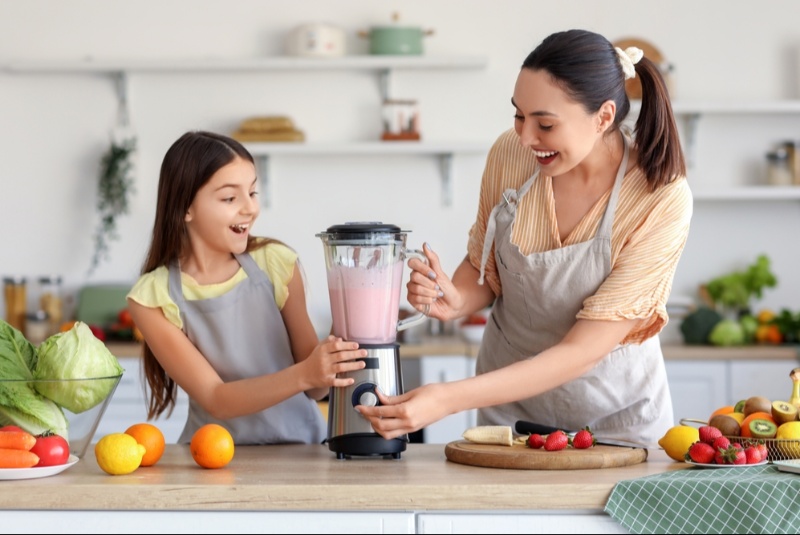A high-quality blender is an essential kitchen appliance, versatile enough to handle tasks from making smoothies and soups to crushing ice and blending sauces. Choosing the right blender can enhance your culinary experience, but with so many options available, it can be challenging to know where to start. This guide provides essential tips for selecting the best blender for your kitchen, ensuring you make an informed and satisfying purchase.
Understanding Blender Types
Blenders come in various types, each suited to different tasks. Countertop blenders are the most versatile, ideal for smoothies, soups, and frozen drinks. Personal blenders are compact and perfect for single servings, making them great for on-the-go lifestyles. Immersion blenders, or hand blenders, are excellent for blending soups and sauces directly in the pot. Understanding blender types helps you choose a model that fits your specific needs and kitchen tasks.
Evaluating Motor Power
Motor power is a critical factor in a blender’s performance. Measured in watts or horsepower, higher motor power means better blending efficiency and the ability to handle tougher ingredients. For general use, a motor with at least 500 watts is sufficient. For more demanding tasks like crushing ice or making nut butter, look for blenders with 1,000 watts or more. Evaluating motor power ensures your blender can handle various ingredients and tasks with ease, providing consistent results.
Considering Blade Quality and Design
The quality and design of the blades significantly impact a blender’s effectiveness. Look for blenders with stainless steel blades, which are durable and resistant to rust. Multi-directional blades or those with varying angles can enhance blending efficiency, ensuring all ingredients are evenly processed. Removable blades can make cleaning easier, while fixed blades may offer better stability during blending. Considering blade quality and design ensures your blender performs well and lasts longer.
Assessing Jar Material and Capacity
Blender jars come in different materials, including glass, plastic, and stainless steel. Glass jars are durable and resistant to stains and odors but can be heavy and prone to breakage. Plastic jars are lightweight and shatterproof but may retain stains and odors over time. Stainless steel jars are robust and do not retain stains or odors, but they are opaque, making it difficult to monitor blending progress. Assessing jar material and capacity ensures you choose a blender that fits your preferences and kitchen needs.
Exploring Speed Settings and Controls
Speed settings and controls determine the versatility and ease of use of a blender. Most blenders offer multiple speed settings, allowing you to adjust the blending intensity for different tasks. Pulse functions provide short bursts of power, useful for chopping and mixing ingredients without over-blending. Some high-end blenders feature pre-programmed settings for specific tasks like smoothies, soups, and ice crushing. Exploring speed settings and controls ensures you have the flexibility to achieve the desired texture and consistency for various recipes.

Considering Ease of Cleaning
Ease of cleaning is an important factor to consider, especially if you use your blender frequently. Look for blenders with dishwasher-safe parts, such as jars, lids, and blades. Removable blades can make cleaning more thorough and convenient. Some blenders offer self-cleaning functions, where you can add water and a drop of dish soap, then run the blender to clean it. Considering ease of cleaning ensures you can maintain your blender easily, promoting hygiene and extending its lifespan.
Evaluating Noise Levels
Blenders can be noisy, which may be a concern if you have a quiet household or small children. Look for blenders with noise-dampening features or designs that reduce noise during operation. Reading customer reviews can provide insights into the noise levels of different models. Evaluating noise levels ensures you choose a blender that fits your comfort level, allowing you to blend without excessive disturbance.
Exploring Additional Features and Attachments
Additional features and attachments can enhance the functionality and convenience of your blender. Some blenders come with travel cups for personal use, food processor attachments for chopping and slicing, or milling blades for grinding grains and nuts. Variable speed controls, timers, and digital displays can provide more precision and ease of use. Exploring additional features and attachments ensures you choose a blender that meets all your culinary needs, making it a versatile tool in your kitchen.
Considering Budget and Value
Blenders are available at various price points, from budget-friendly options to high-end models. Determine your budget and prioritize the features that are most important to you. While higher-priced blenders often offer more advanced features and better build quality, there are many affordable options that provide excellent performance. Considering budget and value ensures you make a cost-effective purchase without compromising on quality and functionality.
Reading Reviews and Seeking Recommendations
Customer reviews and expert recommendations can provide valuable insights into the performance, reliability, and satisfaction of different blender models. Look for detailed reviews that discuss blending performance, ease of use, durability, and overall satisfaction. Professional reviews and consumer reports offer in-depth analysis and comparisons. Additionally, seek recommendations from friends, family, or online cooking communities. Reading reviews and seeking recommendations ensures you make an informed decision based on real-world experiences and expert opinions.
Testing Before Purchase
If possible, test the blender before making a purchase. Visit stores that offer display models you can try. Assess the blender’s build quality, ease of use, and noise levels. Pay attention to how well it handles different ingredients and blending tasks. Testing before purchase ensures you are satisfied with your choice and can avoid potential issues. This hands-on experience can provide valuable insights that specifications alone cannot convey.
Considering Warranty and Customer Support
A good warranty and reliable customer support are important factors when purchasing a blender. Look for brands that offer comprehensive warranties covering parts and labor for several years. Check the manufacturer’s reputation for customer service and support. Having a solid warranty and access to helpful customer support can provide peace of mind and protection against unexpected issues. Considering warranty and customer support ensures you have the backing and resources needed for any future concerns.
Supporting Reputable Brands
Choosing a reputable brand known for quality and innovation can enhance your confidence in your purchase. Established brands often provide better customer support, more comprehensive warranties, and a wider range of replacement parts and accessories. Research brands with a history of producing reliable and high-quality blenders. Supporting reputable brands ensures you invest in a blender that is built to last and backed by reliable service.
Choosing the best blender for your kitchen involves understanding the different types, evaluating motor power, and considering blade quality and design. Assessing jar material, speed settings, and ease of cleaning are essential for selecting a blender that fits your needs. Evaluating noise levels, exploring additional features, and considering budget and value further guide your decision. Reading reviews, testing before purchase, and supporting reputable brands provide additional assurance. Use this guide to navigate the market confidently and find the perfect blender that enhances your culinary creations, providing reliable performance and convenience for years to come.




